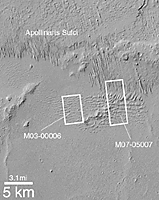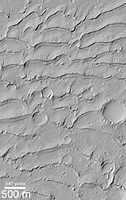

MGS MOC Release No. MOC2-204, 31 January 2000
 (A) Paleodune Context.
|
 (B) MOC View #1
|
 (C) MOC View #2
|
The field of parallel ridges north of the dune field (above the white boxes in picture at the left) is a wind-eroded material named the Apollinaris Sulci. It is possible that the dune field shown here was once covered by this wind-eroded material and was later exhumed. Regardless, the dunes were somehow hardened and have been exposed as hard rock on the martian surface long enough for many impact craters smaller than a few hundred meters (few hundred yards) across to form. These dunes are therefore quite ancient---one might say that this is a 'fossil' dune field. A similar effect at a much smaller scale can be seen by examining some sandstones and siltstones on Earth---if conditions were right, ripples formed in either water or wind are preserved in such rocks.
The first MOC view, labeled M03-00006, was taken on July 1, 1999. The second view, M07-05007, was acquired September 26, 1999. Both MOC images and the Viking picture are illuminated from the left. The dune field occurs east of the Apollinaris Patera volcano and northeast of Gusev Crater at 12.5°S, 181°W.
Images credit: NASA/JPL/Malin Space Science Systems
The paleodunes presented here are also described in an abstract accepted for the 31st annual Lunar and Planetary Science Conference to be held in Houston, Texas, in March 2000. The abstract is ©2000 Lunar and Planetary Institute: "Examples of Martian Sandstone: Indurated, Lithified, and Cratered Eolian Dunes in MGS MOC Images," by K.S. Edgett and M.C. Malin, Abstract No. 1071, Lunar and Planetary Science XXXI, 2000. This is a PDF file. For best results, use your "save this link as" option on your web browser, download to your desktop, then open with appropriate software such as Adobe Acrobat Reader.
Malin Space Science Systems and the California Institute of Technology built the MOC using spare hardware from the Mars Observer mission. MSSS operates the camera from its facilities in San Diego, CA. The Jet Propulsion Laboratory's Mars Surveyor Operations Project operates the Mars Global Surveyor spacecraft with its industrial partner, Lockheed Martin Astronautics, from facilities in Pasadena, CA and Denver, CO.